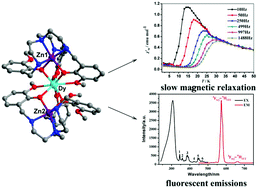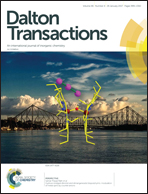3d–4f heterometallic trinuclear complexes derived from amine-phenol tripodal ligands exhibiting magnetic and luminescent properties†
Abstract
A new family of 3d–4f heterometallic trinuclear complexes, namely [M2LnL2]·2ClO4·H2O (H3L = tris(((2-hydroxy-3-methoxybenzy1)amino)ethyl)amine, where M = Ni, Ln = Gd (1), Dy (2), and M = Zn, Ln = Gd (3), Dy (4)) were synthesized via the reaction of H3L and Ln(NO3)3·6H2O and Ni(ClO4)2·6H2O or Zn(ClO4)2·6H2O in a 2 : 1 : 2 ratio in the solution. Complexes 1–4 consisted of three metal ions arranged in an isosceles triangle manner. Magnetic properties investigations showed that complexes 1 and 2 exhibited weak ferromagnetic coupling between the Ni(II) and Ln(III) ions, whereas complex 4 displayed lanthanide single-ion magnetic properties. The alternating current (ac) magnetic susceptibilities of 4 revealed that both the in-phase (χ′) and out-of-phase (χ′′) signals are frequency- and temperature-dependent, which are typical features of the field-induced slow relaxation of the magnetization with Ueff = 124.5 K. Complex 4 also exhibited an obvious butterfly-shaped hysteresis loop at 2 K, indicating that it is a single-ion magnet. Moreover, complex 4 showed stronger fluorescent emissions, which were typical narrow emission bands of lanthanide ions. Therefore, complex 4 can be considered as a molecular magnetic and luminescent material. Comparably, complex 2 showed very weak DyIII-based emissions because the paramagnetic NiII ions quench the fluorescence and thereby lower the population of the triplet state.



 Please wait while we load your content...
Please wait while we load your content...